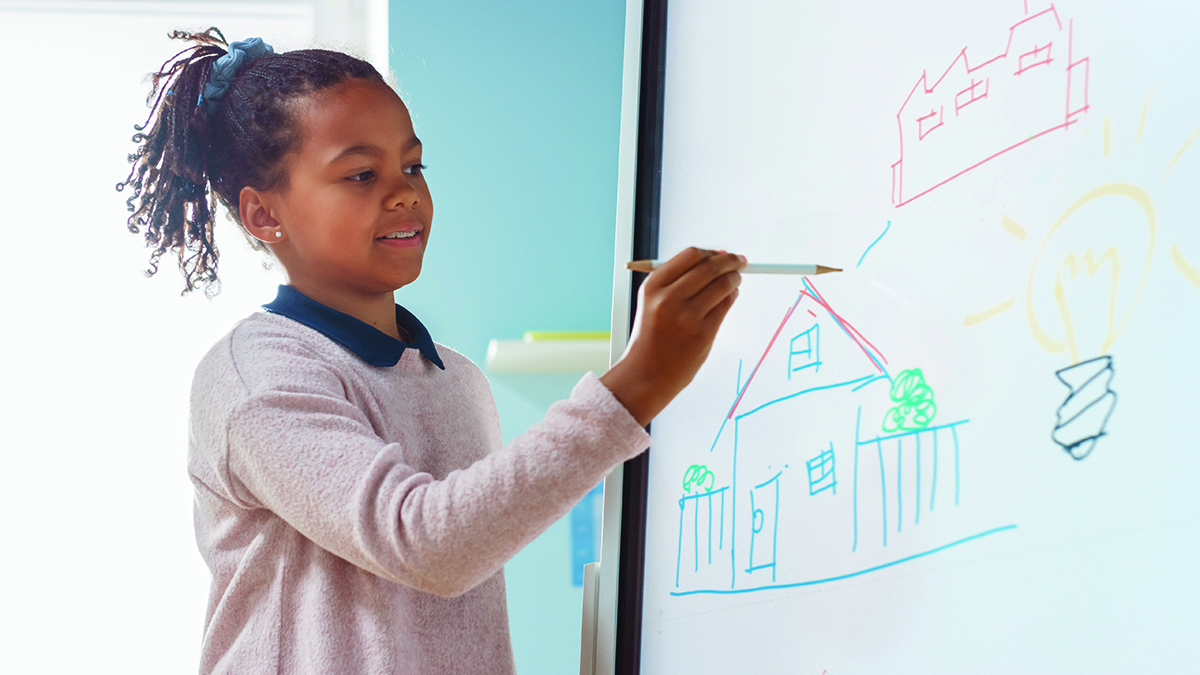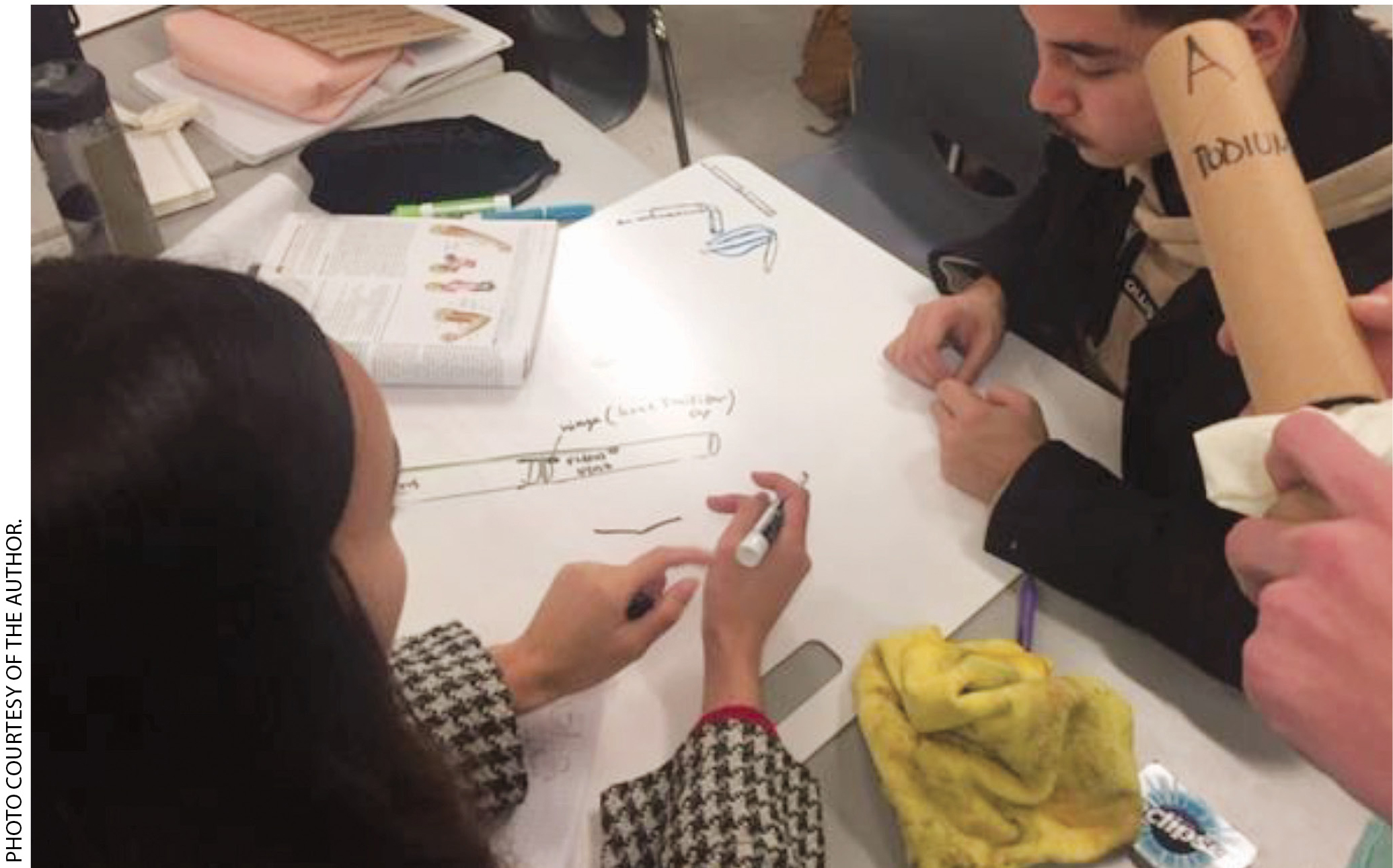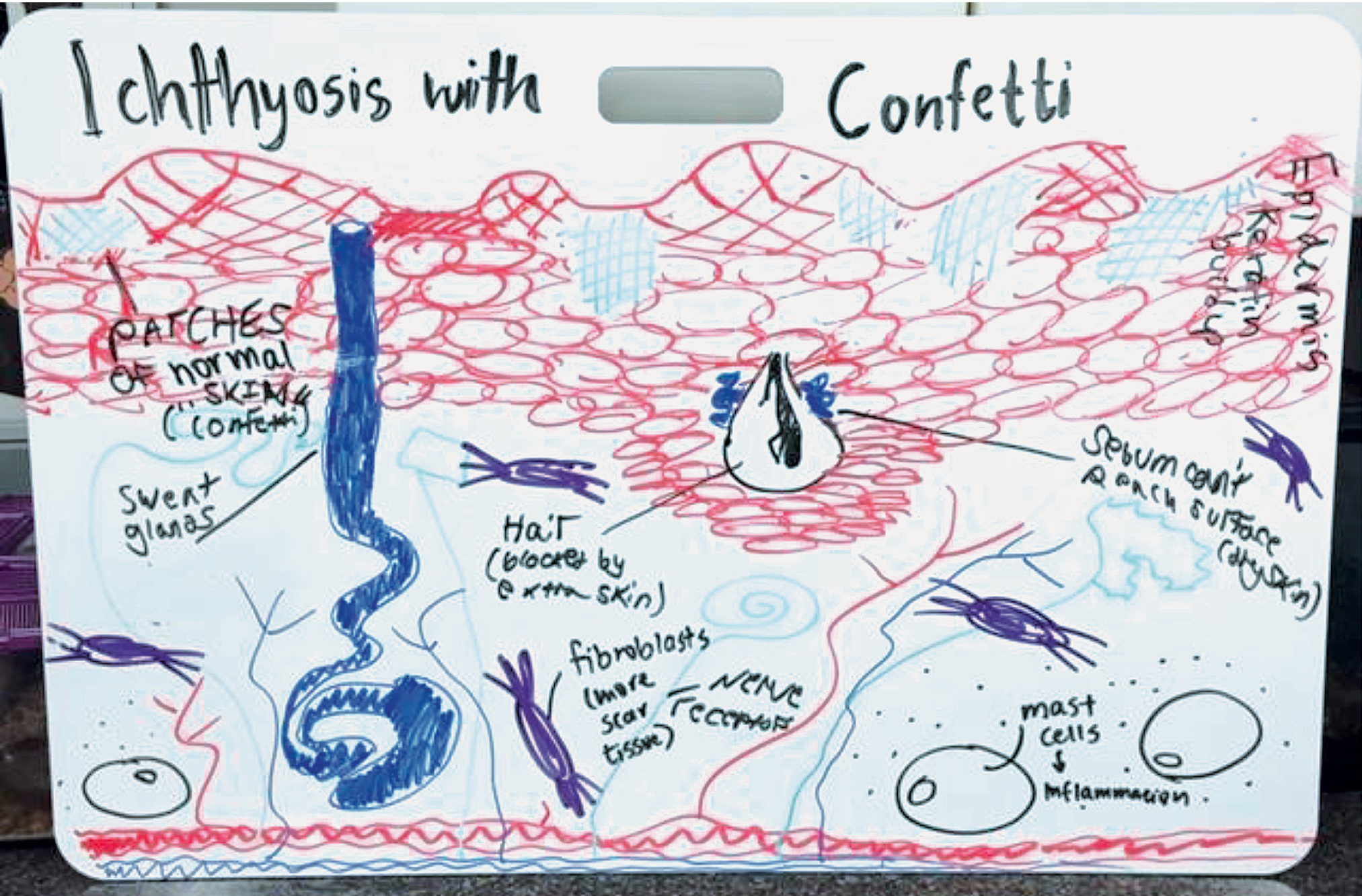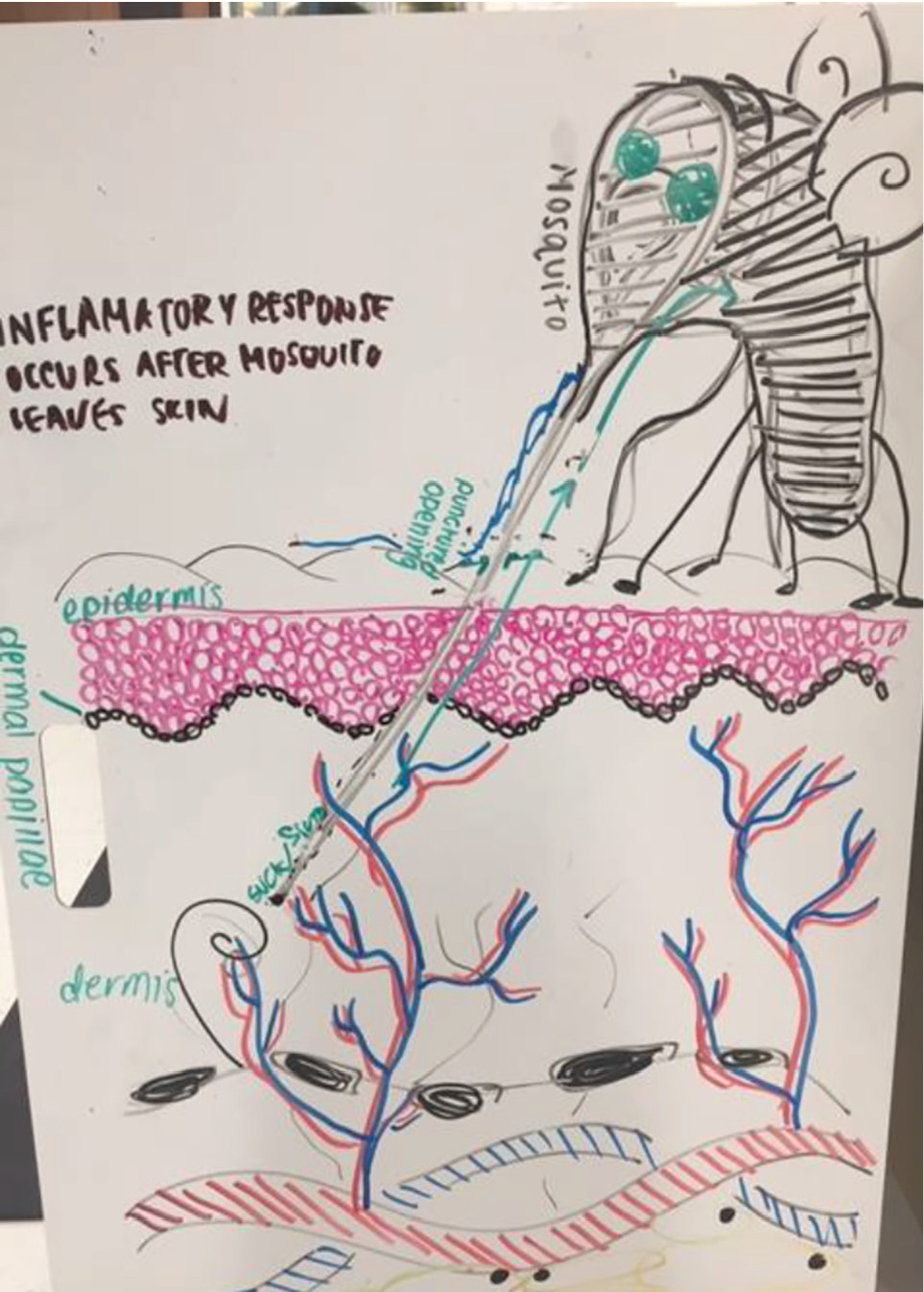feature
Drawing to Learn to Draw Out Student Understanding
Science Scope—July/August 2021 (Volume 44, Issue 6)
By Christine Karlberg, Laura Henriques, and Alan Colburn

We’ve all experienced it . . . the morning we are running late and the internet or copy machine is not working. On the day I had planned for my students to label a squid diagram, the copy machine was down. In the few minutes before the students filed in, I grabbed some scratch paper and practiced drawing the body form of the squid. The body of the squid could be broken down into basic shapes like triangles for the mantle and fins and elongated curved rectangles for the tentacles with circles for the suction cups. Disguising my nervous energy as enthusiasm, I dove into drawing the squid together with students. Using my classroom smartboard, I instructed students on the size and scale of the shapes to make as they drew in their lab journal. Some initial griping by the students soon faded as they became involved in the task. As we drew, I asked questions that related form to function: Why do you think this is here? How is this used to achieve biological success? At the end of the session, we all had good drawings of the anatomy of the squid and a deeper understanding of why, through evolution, the squid ended up with this body plan. This preliminary experience of drawing with my students led me to the eventual use of Drawing to Learn (D2L) interventions—which use student drawings to support understanding—in all my classes.
The idea of using art or drawing in a science class is not new. A quick review of the archives shows that NSTA has published articles for each grade range about ways to incorporate art and drawing into the science classroom. While many teachers use drawing to help hone observational skills (Dirnberger 2006; Glynn and Muth 2008; Matern and Feliciano 2000; ), there are other benefits to including drawing in the science classroom (). Drawings are a rich source of information about how and what students perceive (Fan 2015). When students build knowledge of new content, drawing exercises allow teachers to recognize and determine areas of misconception or inaccuracy and provide feedback, guidance, or more direct instruction for clarification as needed. Additionally, drawings can help enhance engagement and serve as a starting point for reasoning, communications, and sensemaking (Ainsworth, Prain, and Tytler 2011).
What is Drawing to Learn?
D2L is a strategy that uses student drawings to support model building and understanding (Quillen and Thomas 2015). While some teachers may be using sketchnoting in their classrooms (the idea of including sketches and visuals into the note-taking process), D2L is a little different because of the interactive nature and iterative process of revising drawings after conversations and getting new information. D2L contributes to student learning in the affective domain, as well as visual literacy and model-based reasoning. The initial squid drawing described above isn’t D2L, but it did touch on an important element of D2L: affect. A student’s emotional state, or affect, is intrinsically tied to motivation—the amount of time and effort they are willing to commit to learning (Bransford, Brown, and Cocking 2000). D2L proponents highlight the importance of having students explain why they are being asked to draw, which differs from an art class. In science we are drawing to record observations, make sense of interconnected features of a system, communicate ideas, and collaborate with others. Depending on intent, science drawings may give extra attention to some features while ignoring others. As with any teaching technique, maintaining a positive attitude and enthusiasm breeds the same affect in students, and D2L can support this goal.
Quillen and Thomas (2015) defined visual literacy as the skill to read and write visual or symbolic language, including translations between visual and verbal data or ideas. Visual literacy is rarely taught explicitly because teachers tend to be experts in their field and no longer experience the feeling of science as a foreign language. After becoming an expert in any field, a person can easily forget the initial difficulties encountered because practice and frequent usage may have made the content second nature. We have to remember that students are science novices, and we need to help them see like experts. D2L strategies provide scaffolding for students. D2L teachers define the meaning and usage of common symbols in drawings and provide practice with translating relevant, technical vocabulary into drawings.
Developing and using models is a key science and engineering practice within the Next Generation Science Standards (NGSS) classroom and a key D2L strategy. Model-based reasoning is used to solve a problem or explain phenomena. Using multiple iterations of drawings for this purpose forces students to continually revisit and reevaluate their thinking: Do these ideas make sense? How does the new information I just received fit into my initial thinking? Students are challenged to confront the depth and degree of their own understanding and may be driven to adjust long-held misconceptions. As students confront new information through text, discussion, and labs, their understanding changes; their drawings change as well. D2L strategies require discussion and opportunities for iteration. Hearing the ideas of others may allow for conception shift. The drawings make student thinking visible and allow the teacher to individualize questioning to discover depth of understanding. As you will notice in Figure 1, there are multiple sources of information that help students create their model. In this case a textbook and a physical student-made model are used in tandem with the drawings as the student group works to revise their model and make meaning.

Once I better understood the parameters and applications of D2L, I began to integrate the technique more frequently into my curriculum. For example, I incorporated the strategy during a unit in which we focused on skin disorders, the process of tattooing, and the action and adaptations of ectoparasites. Four-person lab groups used large 24” × 36” whiteboards to grapple with the ideas of how particular disorders compromise the homeostasis of the skin, how we permanently mark our skin with tattoo ink, and how ectoparasites combat the skin’s protective mechanisms. Student lab groups received a broad prompt based on these central concepts to address each of these activities: How is homeostasis of the skin impacted with this condition? What makes tattoos permanent? How do adaptations of integumentary ectoparasites make them successful in spite of the protective elements of the skin? This required synthesis of background knowledge as the model was built on the whiteboard. As the members of groups discussed and collaborated, I visited each group and asked students specific questions about what they had drawn and what it meant.
Discussion is essential in D2L activities. The meaning implied by the student may not be understood just by looking at the drawing. When teachers or peers pose questions about drawings, students explain their understanding of concepts and the drawings are a scaffold for this discussion. These discussions provide a window for the teacher into the ongoing learning of the student and serve as a simple formative assessment. This discourse, along with targeted feedback from the teacher, may naturally lead students to edit, change, improve, or add depth to both their drawings and understandings. In addition, drawing and conversations are helpful for EL and special education students. They get practice verbalizing their ideas in a small setting and have an opportunity to focus on sense making in a safe environment.
In addition to sharing their ideas with the teacher, groups can share out their drawing model and ideas with neighboring lab groups or to the whole class. This can take place via gallery walks or short presentations, which include student groups posing questions either via sticky note or orally. This gives students the opportunity for scientific argumentation and extended levels of communication, as audience members suggest alternate ideas or explanations about the phenomenon for the group to consider for the next model iteration. As conceptions change, students edit their models to reflect new thinking. Earlier iterations of drawings can be archived via photographs. In the case of the first author, when it was time to move onto the next lesson, students photographed their whiteboard before erasing it so that their model could be copied or printed out and affixed into their individual lab journal for future use and reflection. Pictures of student work (from other class sections) in various stages can also be used for assessment, where students are prompted to critique the model.
Teacher tips for using D2L
Want to try D2L in your classroom? Here are some suggestions to help you get started:
- Planning is key (see Getting started). As so much of this type of teaching is about reacting to and building off of individual student thinking, classroom culture and the conceptual flow of a unit must be established well in advance.
- Dismantle the “I can’t draw” mindset that students might have by drawing together as a class. Deconstruct content into a series of interlocking basic shapes and model a growth mindset; it’s okay to make mistakes because we can always erase and try again.
- Dismantle the “I can’t draw” mindset that you might have. Relax and release the role of teacher as expert and laugh when something doesn’t work; your enthusiasm and humility will open student affect and create a more collaborative class culture. If you are hesitant about drawing, practice and then practice some more. Drawing practice does not need to create perfection, but it will certainly build confidence for you and your students.
- Consider using drawing templates to scaffold until this confidence and comfort is built. If you use slides in a lesson or lecture, you can embed slides within your deck that create your desired learning pathway to serve this purpose. The slides would provide the scaffolding for students to get started on their own drawings. Recognize students might not follow the scaffolding as their drawings take them in new directions, but the scaffolding slides will be in the slide deck for them to revisit if so desired.
- Circulate between groups as they are drawing and discussing. Check on progress, ask students to explain their drawing and thinking, and be on the lookout for potential misconceptions that could block greater understanding.
- Change the way you respond to questions; instead of simply answering, volley it back to students with a stem like “What do you think it means?” or “Tell me more about that . . .” As there is no “correct” answer here, students may be more willing to share their thoughts and ideas.
- When assessing student drawings (formally or informally), consider the ways that students use colors, labeling, arrows, and explanatory text. Not all features of the model should be drawn in great detail, only those that are critical for understanding the phenomenon at hand (see Figures 2 and 3).


Getting started
Here are some pointers to help you implement drawing in your science lessons:
- Determine where drawings, diagrams, or models fit into a learning sequence. Ideally you will want to have multiple opportunities for student groups to revisit and revise over the course of the unit.
- Identify a phenomenon or scenario around which students can draw and discuss. Be sure to select something that is rich enough to elicit discussion and require revisions.
- Decide where and how many times students will go back to their drawings to revise. As students gain new information, they can go back to their groups to modify their drawing and clarify their thinking. The iterations can take place within a single class or across multiple class periods.
- Sharing early models of student drawings via gallery walk, student presentations, and paired group discussion is an important part of students making their thinking public and soliciting feedback and input. Student and teacher questions can help clarify thinking and pose new scenarios.
- Groups of four work well. Larger groups can result in students not having enough to do, so some may remain passive. Knowing your students is important when considering grouping. Try to include a strong, thoughtful, empathetic leader in groups with special education or EL students. When possible, having heterogeneous academic levels in the same group provides for fruitful conversations. This is a less important consideration than providing the strong leader in groups that need that scaffolding.
There are tools we can use in the online environment that allow students to engage in these activities. Jamboard, Google Slides, or Google Drawing can serve as mechanisms that allow groups to interactively collaborate in a virtual environment. The same guidance and instructions can be provided in this forum as in person. Touch pads or e-pencils will enable students to do better drawings than if they need to draw with a mouse, but annotated group images can be created. An alternative is for students to draw on a physical whiteboard or paper and upload photographs of their drawings.
D2L activities center the classroom on the students and make their thinking visible. Students discover how and why something happens. These techniques may make content more memorable and are likely to transfer to other areas of study over the course of the year and beyond. So grab a pencil or a whiteboard marker and get started. As you and your students employ D2L strategies, you’ll see their thinking, but more important, they will too. •
Christine Karlberg (christine.karlberg@ocsarts.net) is a science instructor at the Orange County School of the Arts in Santa Ana, California. Laura Henriques is a professor of science education and Alan Colburn is a professor of science education, both in the Department of Science Education at California State University Long Beach.
Biology Interdisciplinary Life Science Literacy STEM Teaching Strategies Middle School Pre-service Teachers


